-
The Hyundai Palisade SUV is a three-row family SUV that was updated with fresh looks in 2023.
-
I was impressed by the Palisade’s smooth driving experience, luxurious cabin, and tech features.
-
The Hyundai Palisade in Calligraphy trim is one of the finest family SUVs I’ve ever experienced.
Hyundai introduced its flagship Palisade SUV in 2019, competing against rival three-row family SUVs from Honda, Toyota, and Nissan.
Since then, the Palisade and its corporate sister, the Kia Telluride, have been sales darlings that critics love.
Hyundai updated the Palisade in 2023 to help it remain competitive with newer offerings from Honda, Mazda, and Chevrolet. The update included revised styling, new convenience features, and updated tech.
The updates seem to have worked. Palisade sales jumped 8% in the US in 2023 compared to the prior year.
I recently spent a week driving a 2024 Hyundai Palisade in Calligraphy trim with all-wheel-drive around suburban Atlanta.
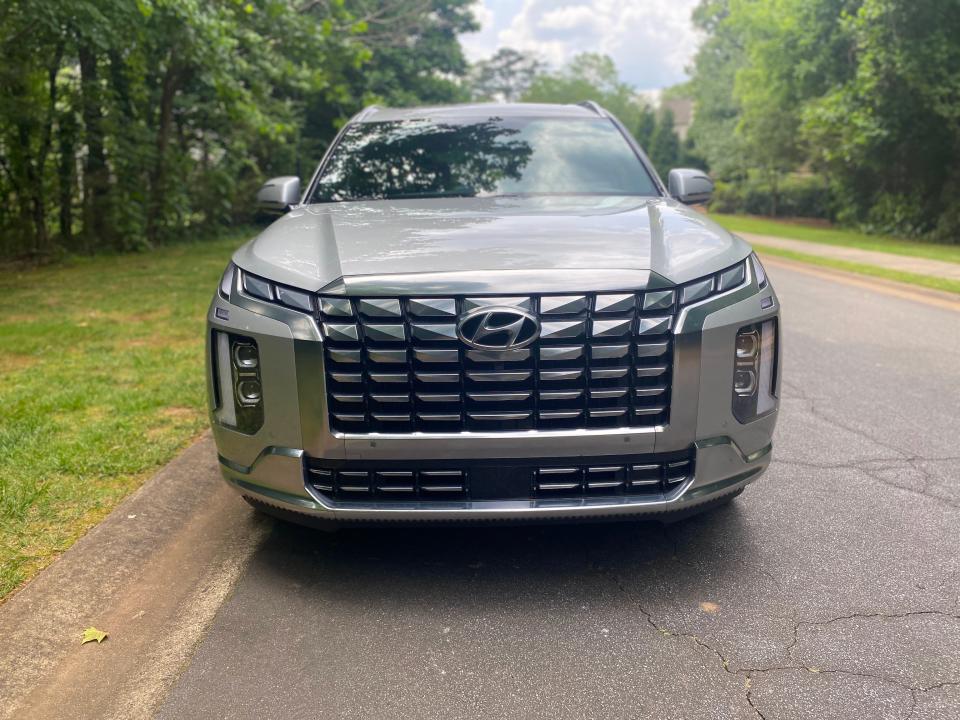
I was genuinely impressed by the premium look and feel of the Palisade. The big Hyundai also offers a great complement of tech and safety features.
The Palisade is available in six different flavors, with the base front-wheel-drive SE trim starting at $36,650. The lineup tops out with the all-wheel-drive Calligraphy Night edition at $53,850.
My fully loaded Hyundai Palisade Calligraphy AWD test car starts at $52,100. With fees, the Ulsan, South Korea-built SUV’s as-tested price is $53,650.
The most noticeable update is the stylish chrome grille.
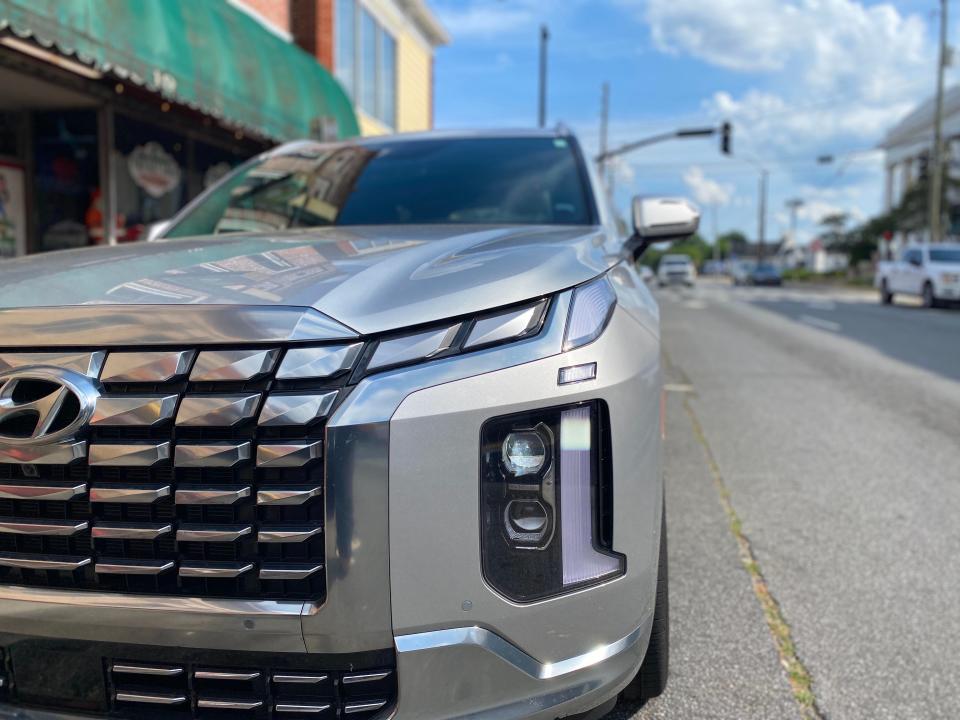

The updated grille work brings the flagship Palisade in line with Hyundai’s new corporate aesthetic that debuted with the compact Tucson SUV’s parametric jewel pattern grille.
The XRT and Calligraphy Night trims have their chrome grilles blacked out.
Like on the smaller Hyundai Tucson, the Palisade’s headlights are on either side of the front grille.
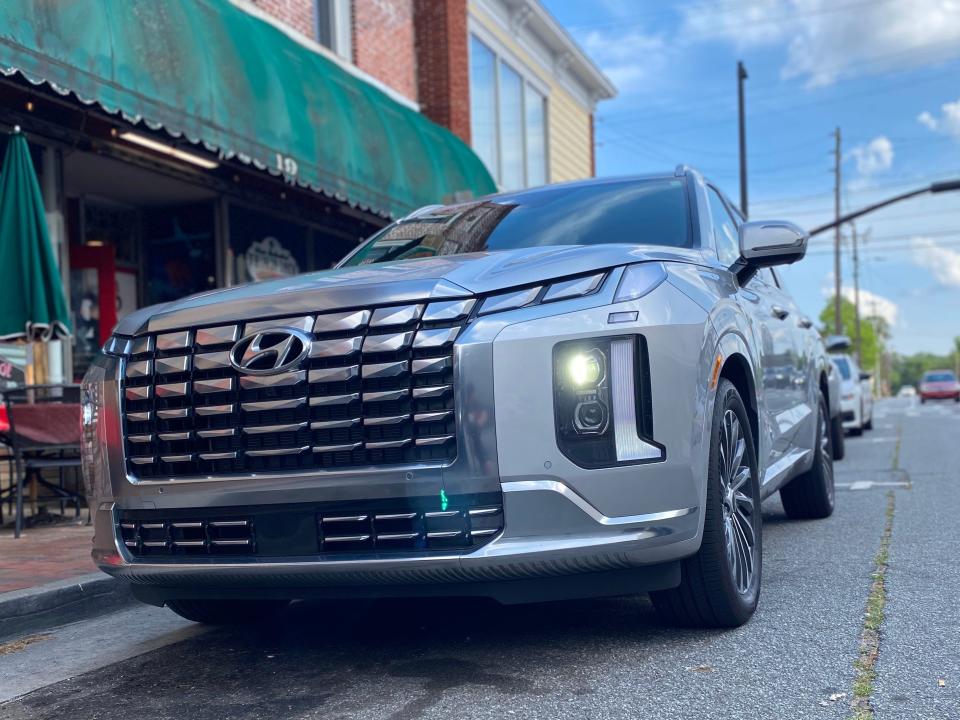

The LED daytime running lights are located on the outside the round headlights.
When not activated, the turn signals above them blend in as part of the chrome grille.
The Palisade’s rear-end received minimal changes.
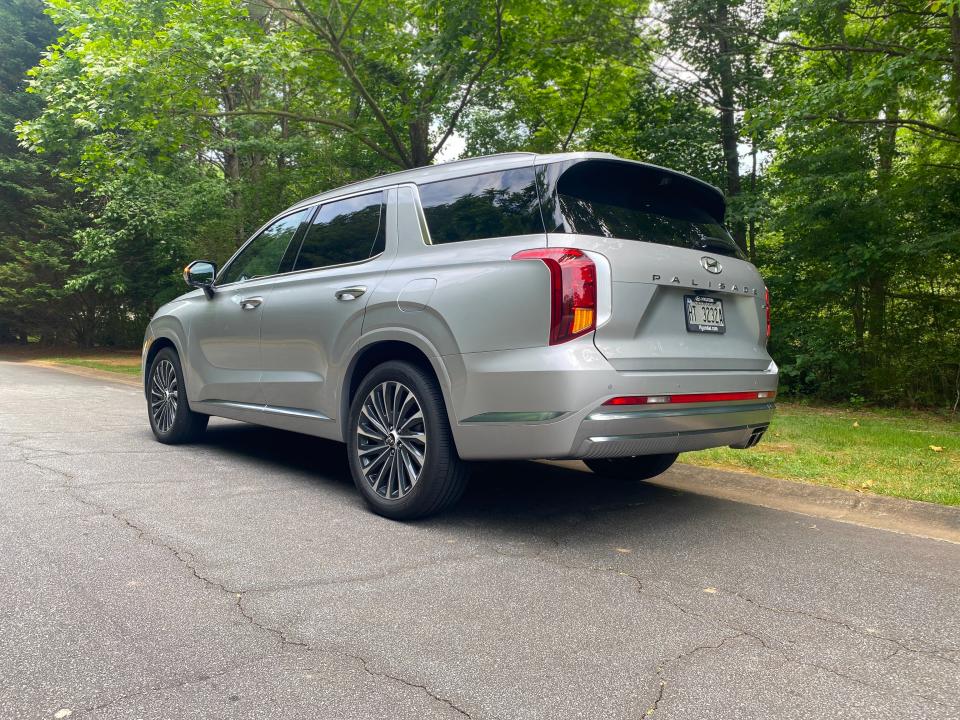

The primary updates to the rear end include a redesigned bumper and relocated reverse lights.
The Palisade’s maximum towing weight remains unchanged at 5,000 pounds when a hitch is installed.
The updated Palisade is half an inch longer than before, mostly due to the new front grille.
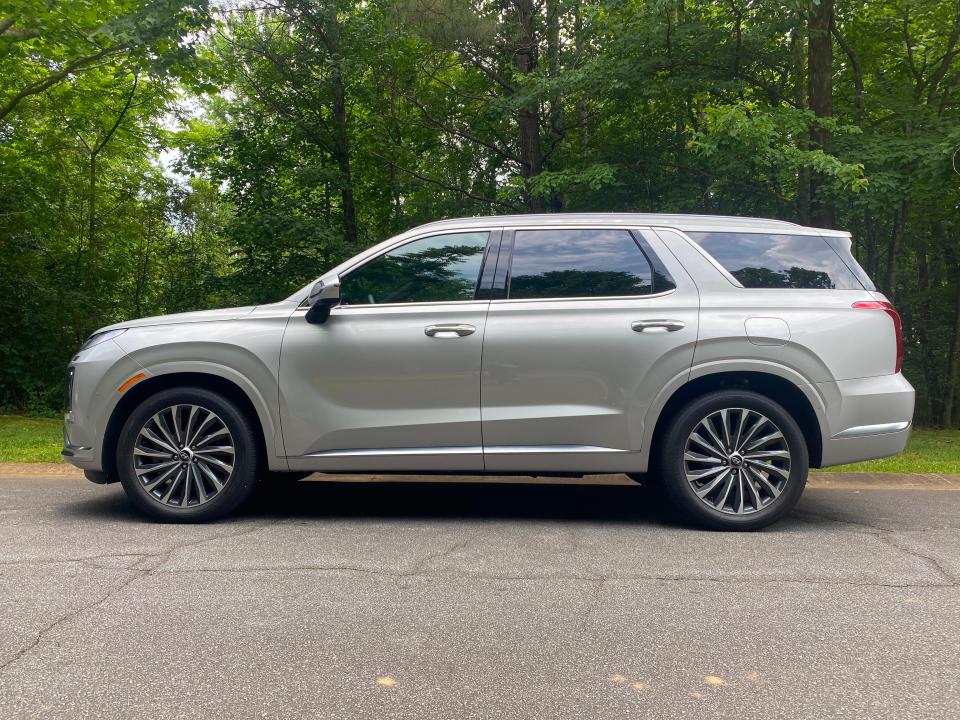

At 196.7 inches longer, the Palisade is about two inches longer than the Toyota Highlander and four inches shorter than the Honda Pilot.
The Palisade boasts 7.9 inches of minimal ground clearance, which is on par with the Toyota Highlander but falls behind the Subaru Ascent’s 8.7 inches.
The only engine available on the Palisade is Hyundai’s 3.8-liter, naturally aspirated Lambda II V6 engine.


The 3.8-liter V6, shared with the Kia Telluride, produces 291 horsepower and 262 lb-ft of torque. It’s paired with an 8-speed automatic transmission.
The Palisade boasts Environmental Protection Agency fuel economy figures of 19 mpg city, 24 mpg highway, and 21 mpg in combined driving.
The quiet, smooth-revving V6 delivers competitive fuel economy for the segment, matching the Subaru Ascent’s turbocharged four-cylinder and the Honda Pilot’s 3.5-liter V6.
To help save fuel, the Palisade is equipped with the universally loathed automatic stop-start system. A button on the center console temporarily defeats the system, but it will reset after the vehicle is turned off. Fortunately, Hyundai’s system is one of the less abrupt and intrusive systems I’ve encountered.
The Palisade puts that V6 power to the pavement through Hyundai’s HTRAC all-wheel-drive system.
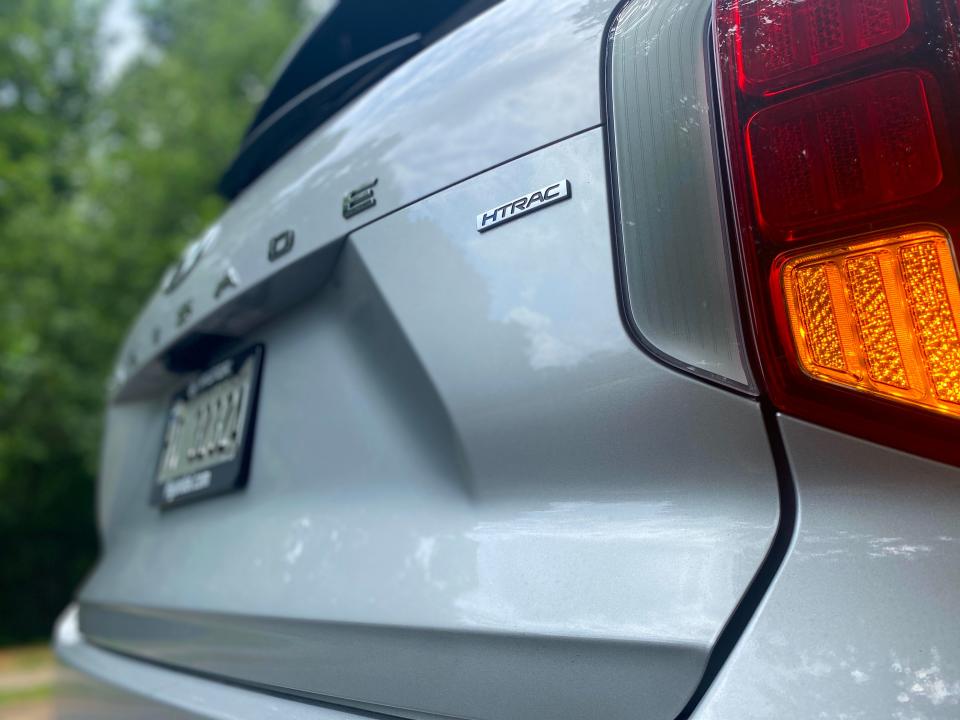

Hyundai Palisade is naturally a front-wheel-drive crossover SUV.
HTRAC is available as a $2,000 option on all trim levels except the top-of-the-line Calligraphy Night Edition, which gets it as a standard feature.
HTRAC operates in front-wheel-drive when cruising around but can send up to 50% of the engine’s power to the back wheel when needed. At low speeds, the driver can activate an AWD Lock function that forces the system to send at least 20% of the power to the back wheels. This is useful for driving in poor road conditions or when driving off-road.
The driver can choose from five drive modes using a rotary dial on the center console.
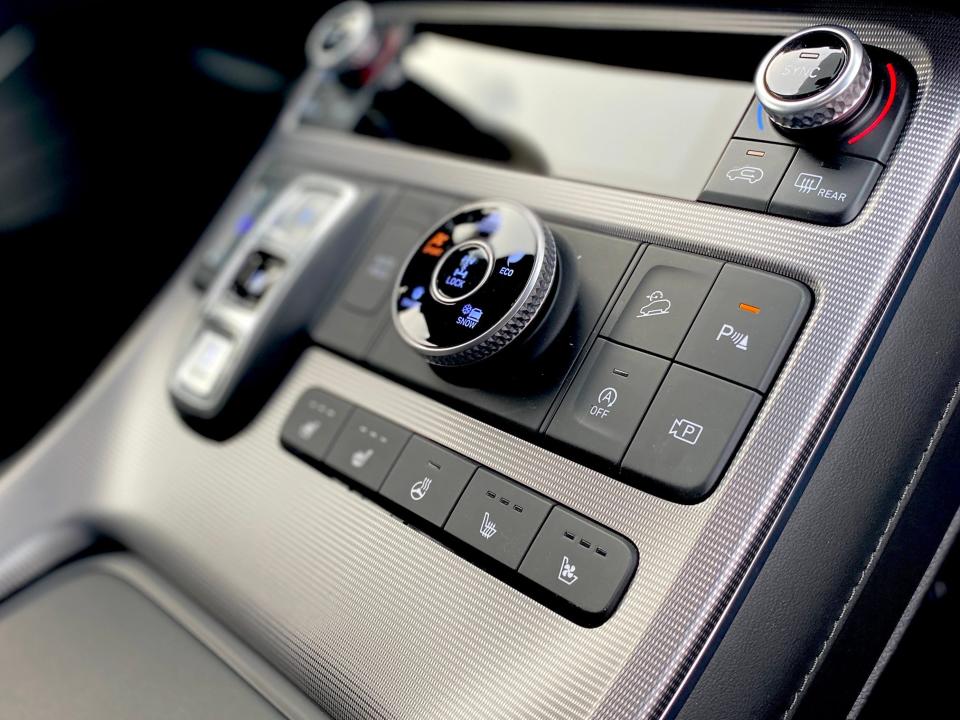

The five modes are Snow, Eco, Comfort, Sport, and Smart.
I did not notice any appreciable performance and fuel economy difference when using the different give modes.
It’s pleasant and refined to drive.
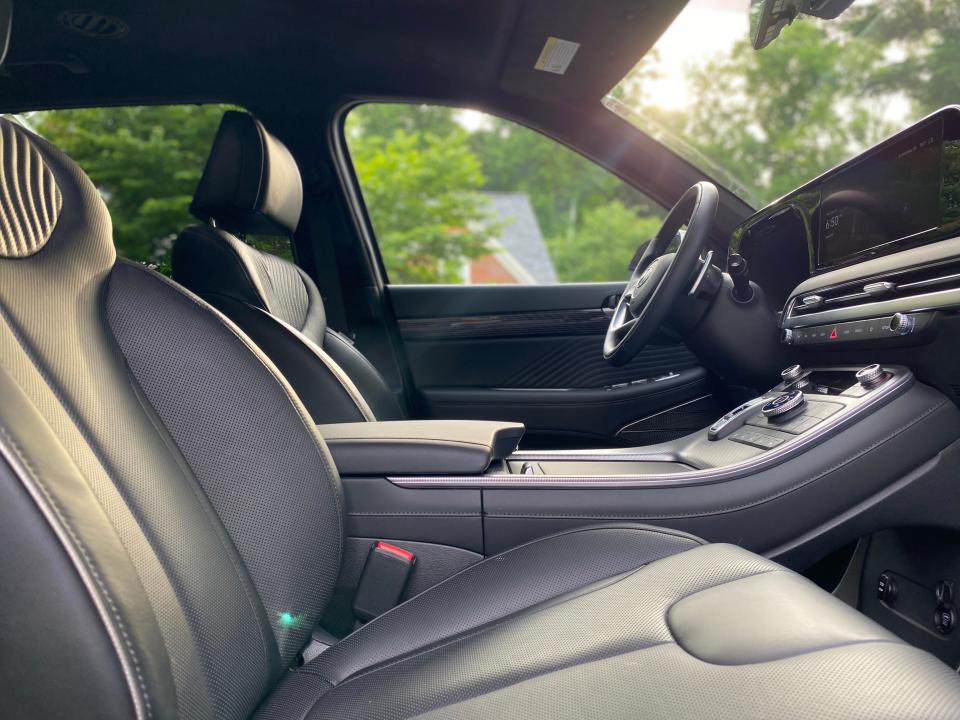

The 4,500-pound SUV handled winding mountain roads with relative ease. Steering was quick and more direct than expected for a vehicle in this segment.
The naturally aspirated V6, which makes most of its power higher up in the rev band, doesn’t quite have the low-end grunt of a turbo or the instant torque of an electric-assisted hybrid. However, this minor shortcoming is only truly noticeable under hard acceleration.
According to Motor Trend, the AWD Palisade Calligraphy can sprint from 0 to 60 in a respectable 6.9 seconds.
But aggressive acceleration is not really what the Palisade is geared to do.
Smoothness is the name of the game here.
Hence, in most daily driving situations, the Palisade delivers effortless power and more than sufficient acceleration.
Honestly, in a segment that’s increasingly moving toward turbocharged four-cylinders or hybrids, it’s refreshing to experience a good old-fashioned V6.
The Palisade’s cabin impressed as well.
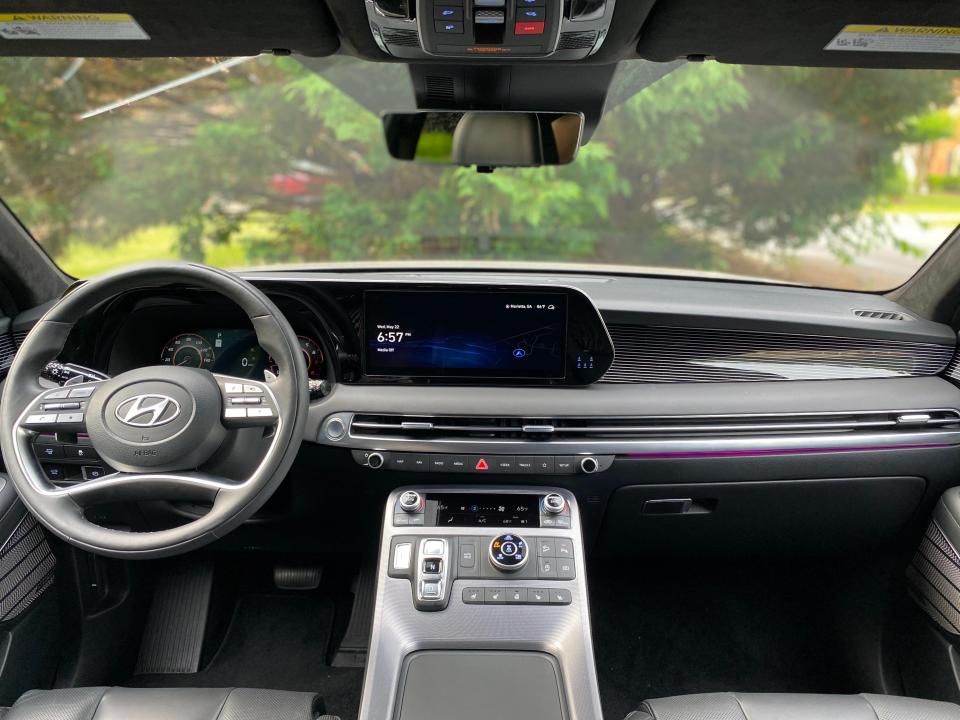

The quiet, isolating cabin contributes to the Palisade’s refined, smooth driving experience. Hyundai did a great job with cabin ergonomics with a sensible mix of touch controls and physical switchgear. There’s also a variety of useful storage scattered throughout the cabin.
The interior’s fit and finish are excellent.
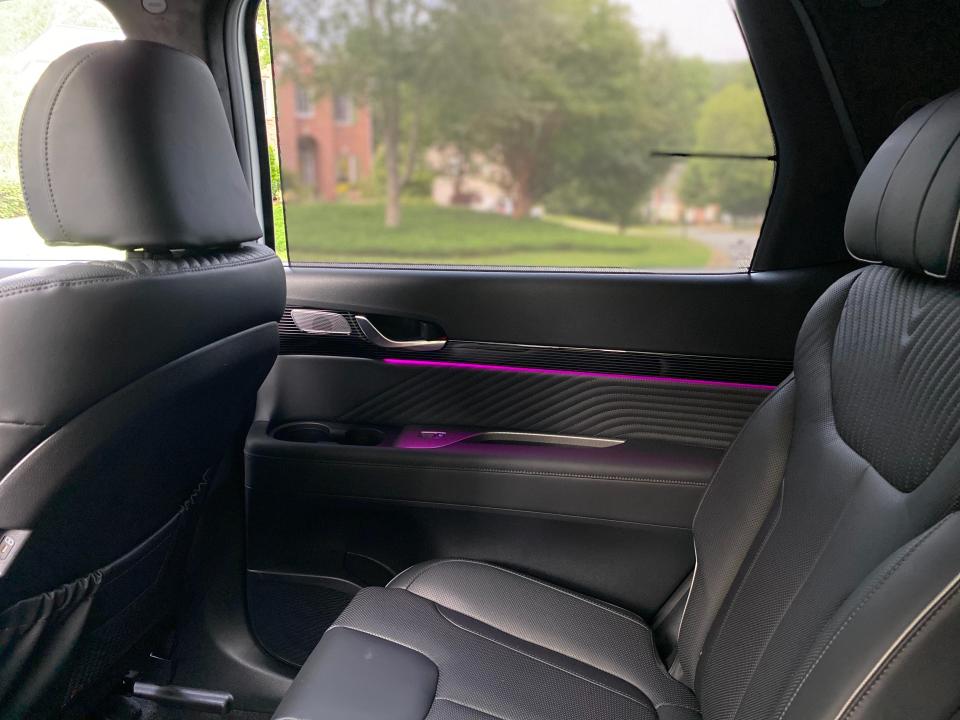

The leathers, plastics, and soft-touch materials used in the cabin are exceptional, especially for a mass-market vehicle. The multi-color ambient lightning adds a little extra panache to the cabin, especially at night.
The Palisade Calligraphy also comes standard with noise-reducing acoustic side glass.
Instead of a single panoramic glass roof like those found in the Subaru Ascent or Honda Pilot, the Palisade has two individual sunroofs.
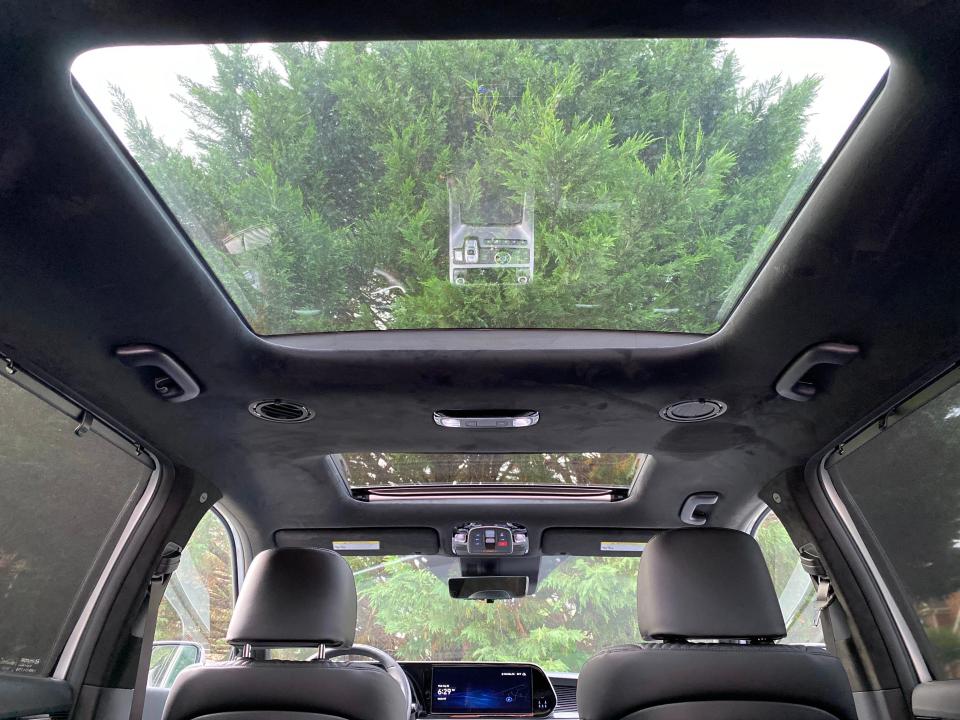

The smaller front sunroof opens, but the larger rear glass roof does not.
In front of the driver is a heated leather-wrapped steering wheel with paddle shifters and a 12.3-inch digital instrument display.
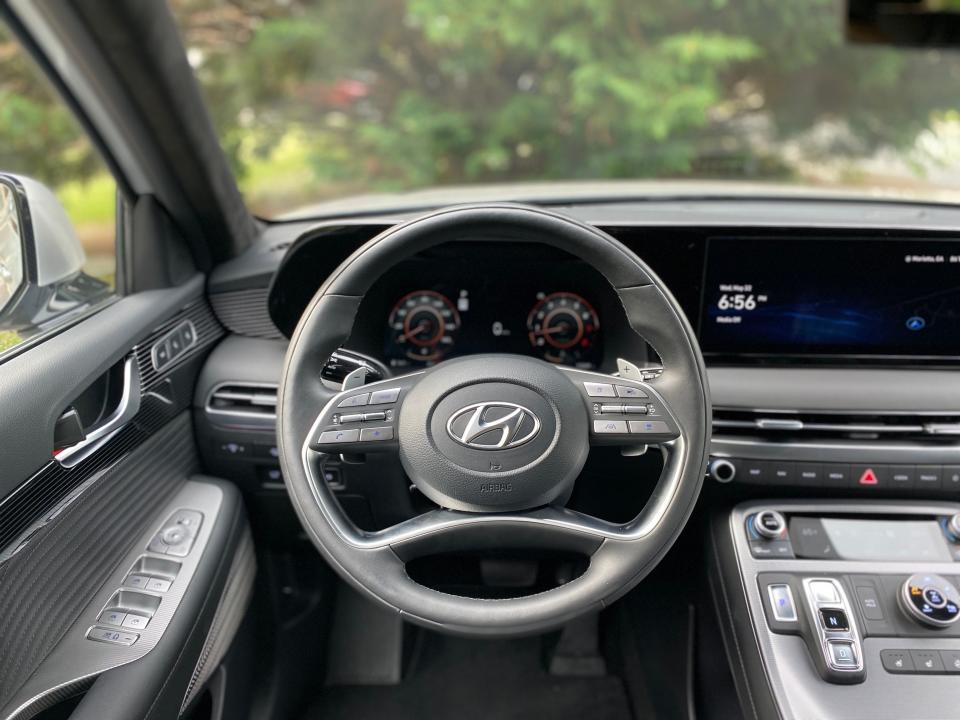

The configurable digital instrument cluster changes based on the drive mode the car is in or can be manually adjusted to suit the driver’s taste.
The digital instrument display is also where the blind spot view monitor lives.
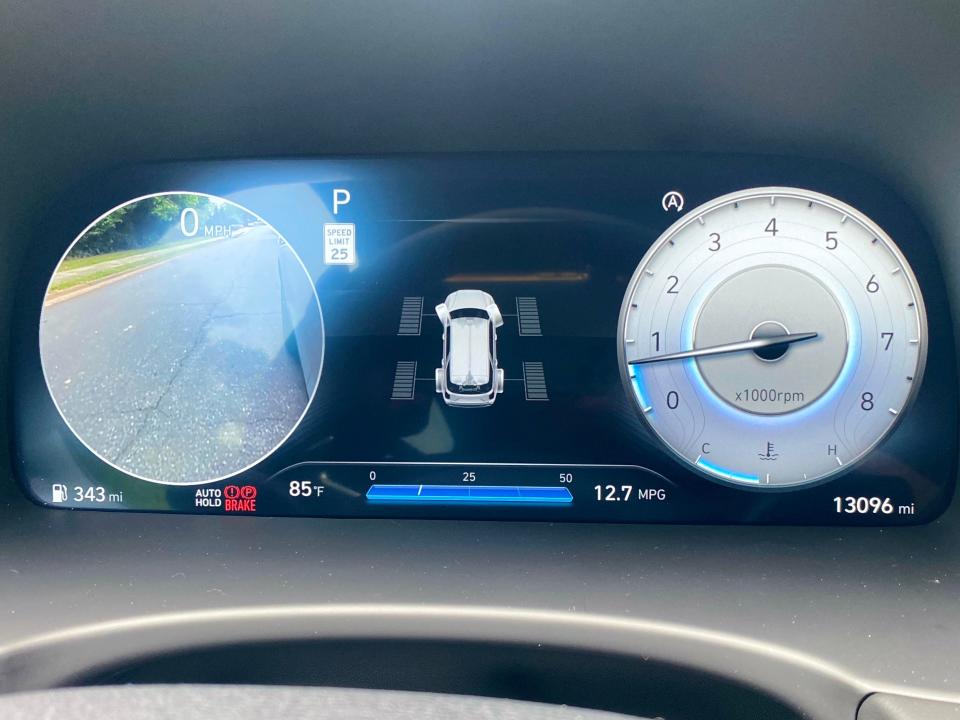

The system uses side mirror-mounted cameras to give the driver a live view of the vehicle’s blind spot when the turn signal is activated.
Also, in front of the driver is a color head-up display.
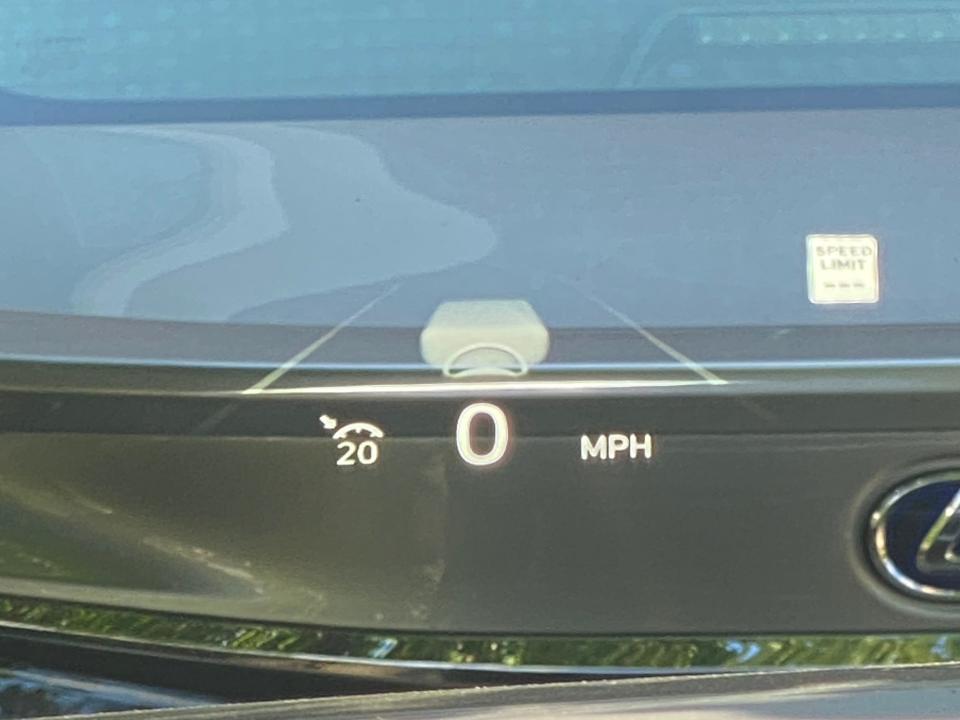

The HUD can be configured to present various information, including speed, the status of the advanced cruise control, and the speed limit.
The leather-trimmed seats, exclusive to the Calligraphy trim, were soft and supportive.
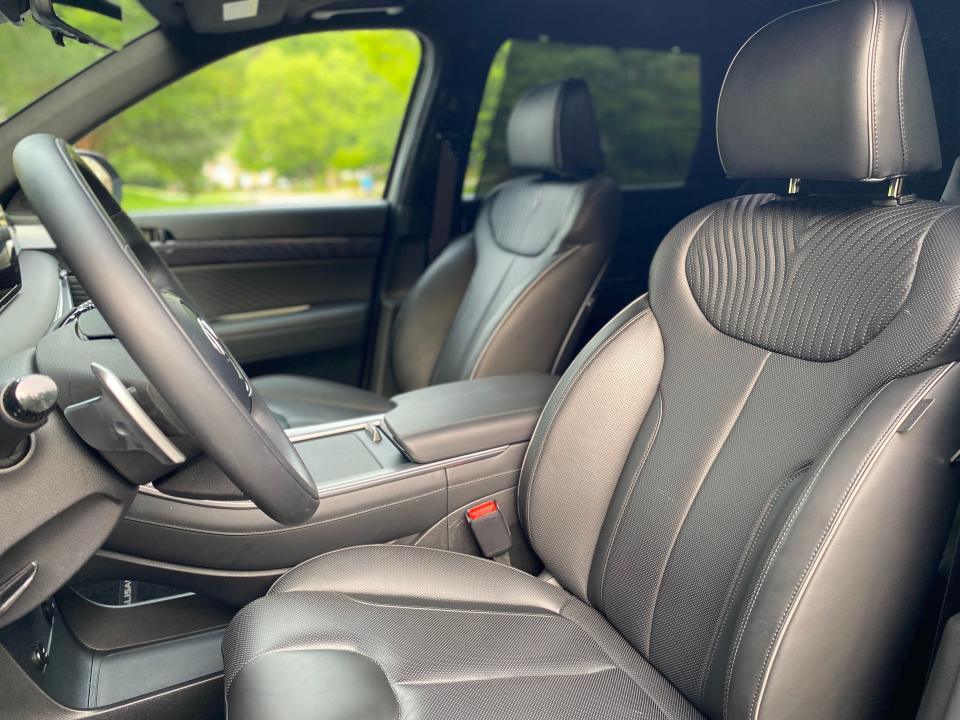

The driver’s seat’s Ergo-Motion function uses self-adjusting inflatable air pockets to support the driver’s posture and combat fatigue on long drives. When the Palisade is in Sport Mode, the air pockets inflate to provide additional lumbar support.
The top trim comes standard with heated and ventilated front seats.
The front dash is dominated by a 12.3-inch touchscreen.
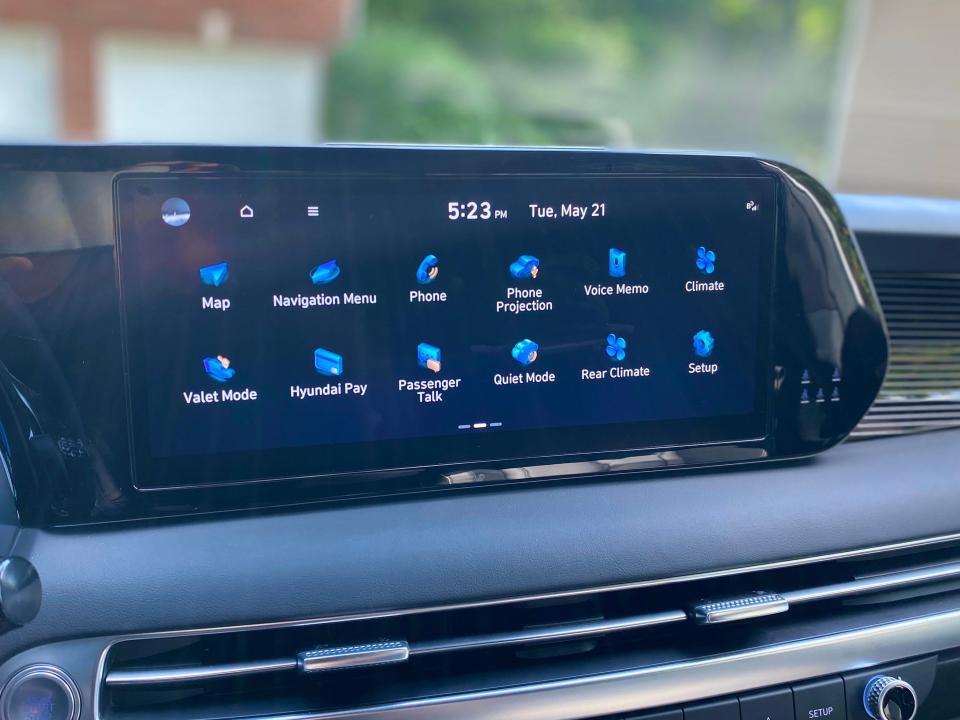

The Palisade comes standard with a built-in navigation system that can receive updated maps remotely and a wifi hot spot.
It also comes standard with wired Apple CarPlay and Android Auto.
The Calligraphy trim comes with front, rear, and side cameras.


The cameras come together to provide the driver with a 360-degree view of the Palisade and its surroundings.
The Palisade’s rearview mirror is equipped with a smart rear-vision camera display, which comes in handy when the cabin is loaded up with cargo.
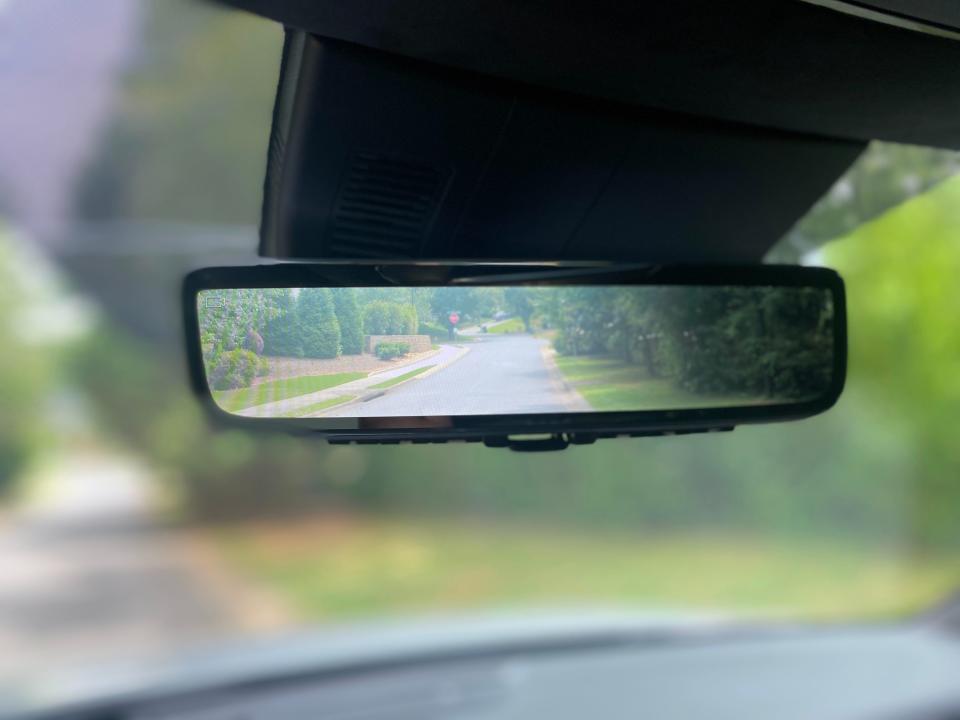

The actual camera is located near the top of the rear window.
Right above the rearview mirror is a retractable panoramic mirror.
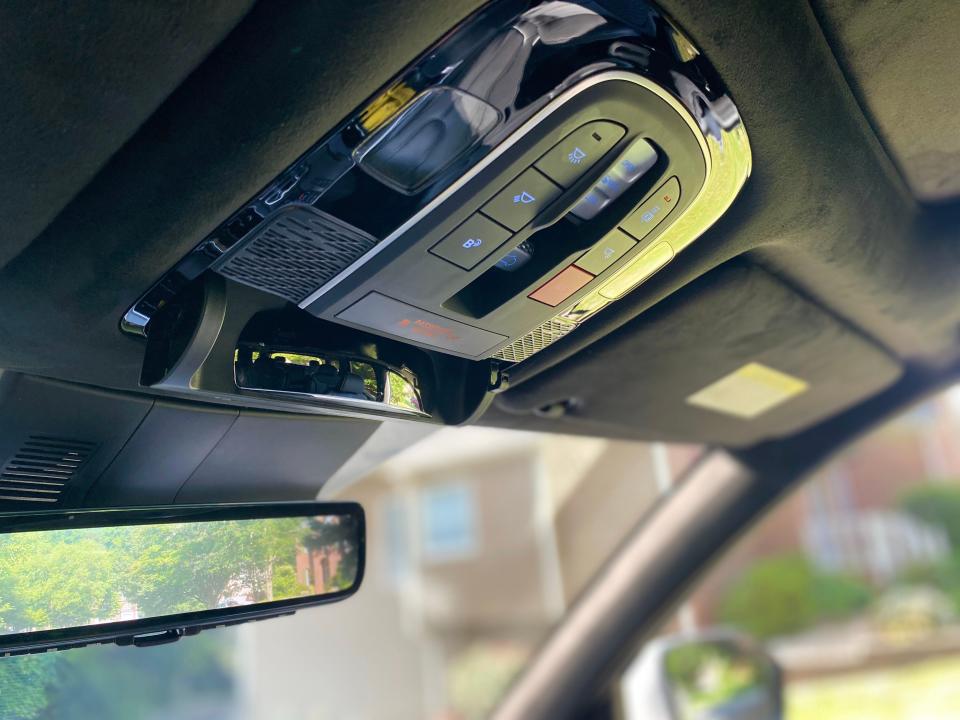

The panoramic mirror gives the driver a clear view of the action in the back of the vehicle. The Palisade also has a Passenger Talk feature that amplifies the driver’s voice through the speakers in the rear cabin.
Atop the center console is a stand-alone, touch-sensitive climate control screen.
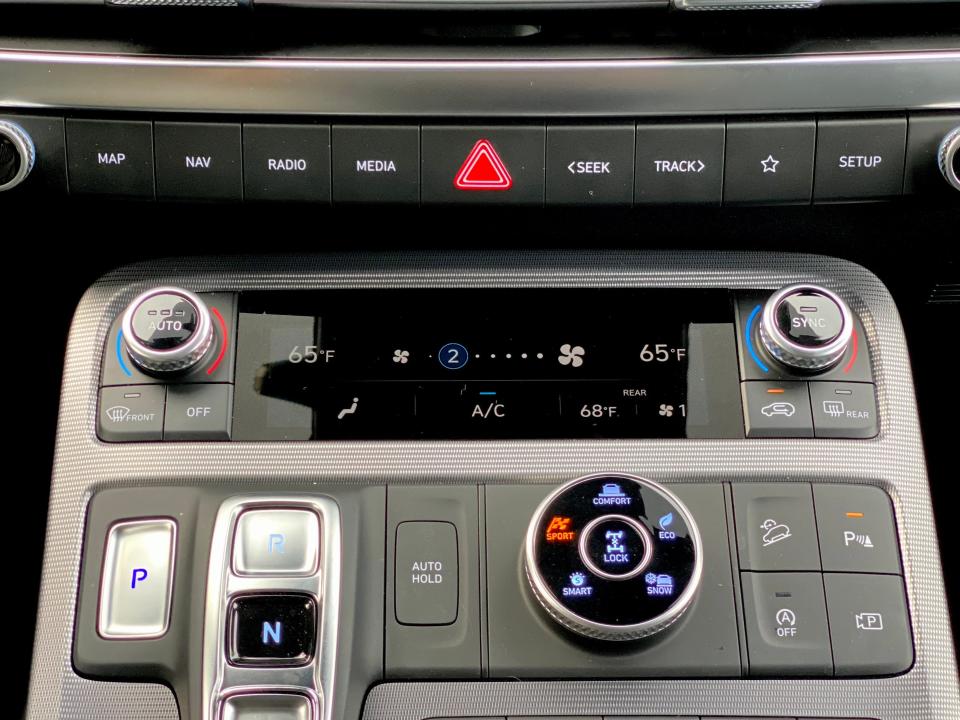

I really liked this setup. It’s a prime example of finding the perfect balance between virtual touch controls and physical buttons.
Instead of a shift lever, the Palisade uses push button controls to put the vehicle into gear.
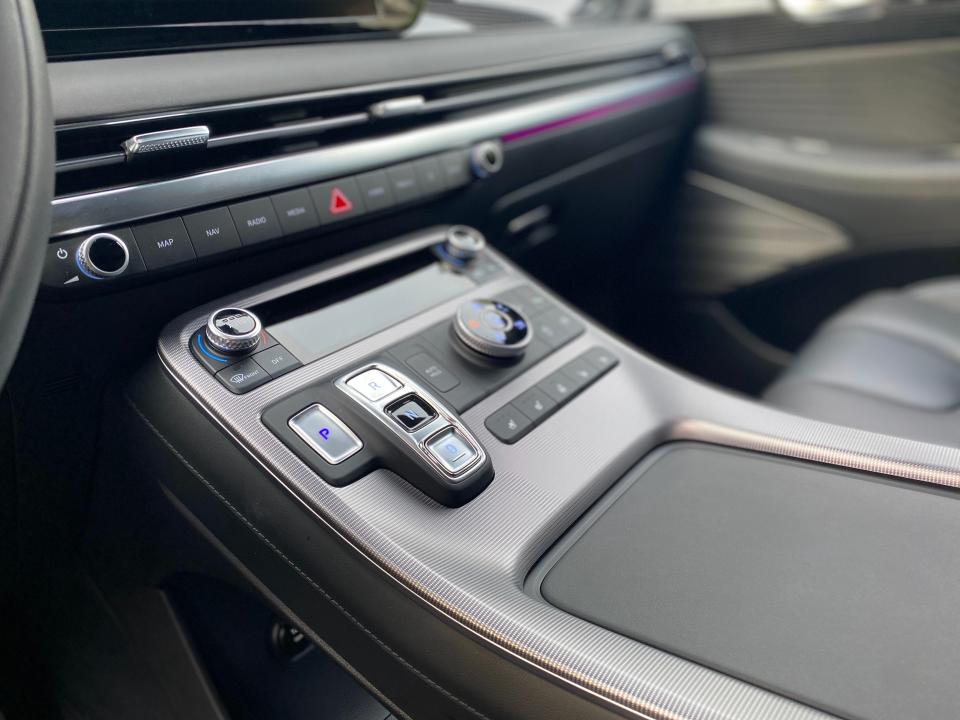

Hyundai’s choice of a push-button shifter over a lever opens up the center console, giving the driver easier access to the drive mode selector and climate controls.
Open up the center console’s sliding cover reveals a large story area.


The compartment is home to the Palisade’s trick foldable cup holders that tuck away when not used. This is also where you’ll find a wireless charger and the USB-A plug for Apple CarPlay.
A hidden storage area under the center console is perfect for bags or small purses.
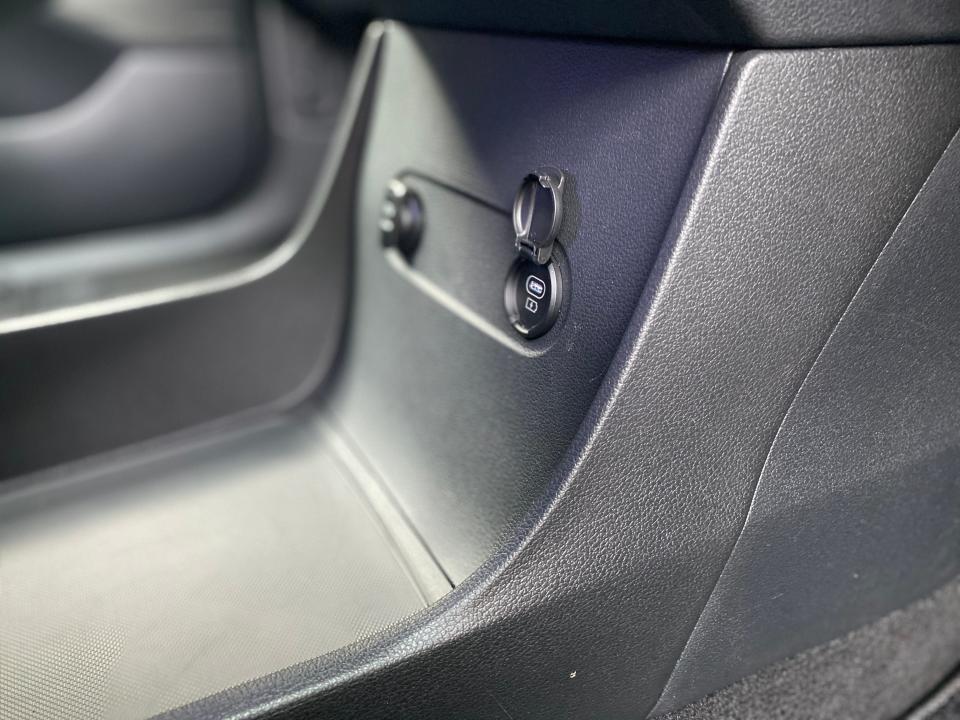

The storage nook is also home to USB-C and 12V plugs.
There’s also storage, a 12V plug, and a USB-C plug under the armrest.
I enjoyed the sound quality of the Palisade’s surround sound system.
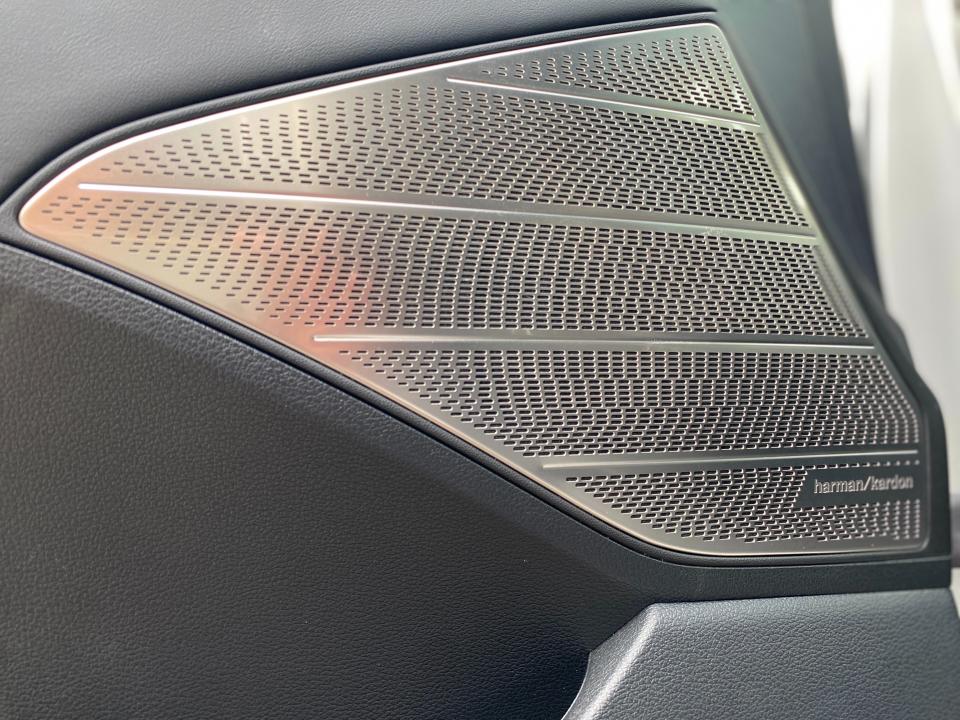

The 12-speaker Harmon Kardon system is standard on higher trims and available as an option on the SEL trim.
One of my favorite features is Quiet Mode, which limits the volume of the front speakers and mutes the speakers in the rear cabin, allowing its occupants to rest without disruption on a road trip.
All Palisades except the base SE trim come standard with captain’s chairs.


The captain’s chairs on the Calligraphy trim are equipped with folding “wing-out” headrests, similar to those found on airplane seats.
The Palisade’s second-row offers an impressive 42.4 inches of legroom which is nearly four inches more than the Subaru Ascent and Toyota Highlander and about an inch and a half more than the Honda Pilot.
The Calligraphy’s second-row seats are also heated and cooled.
The rear cabin climate and seat heat/ventilation controls are between the front seats.
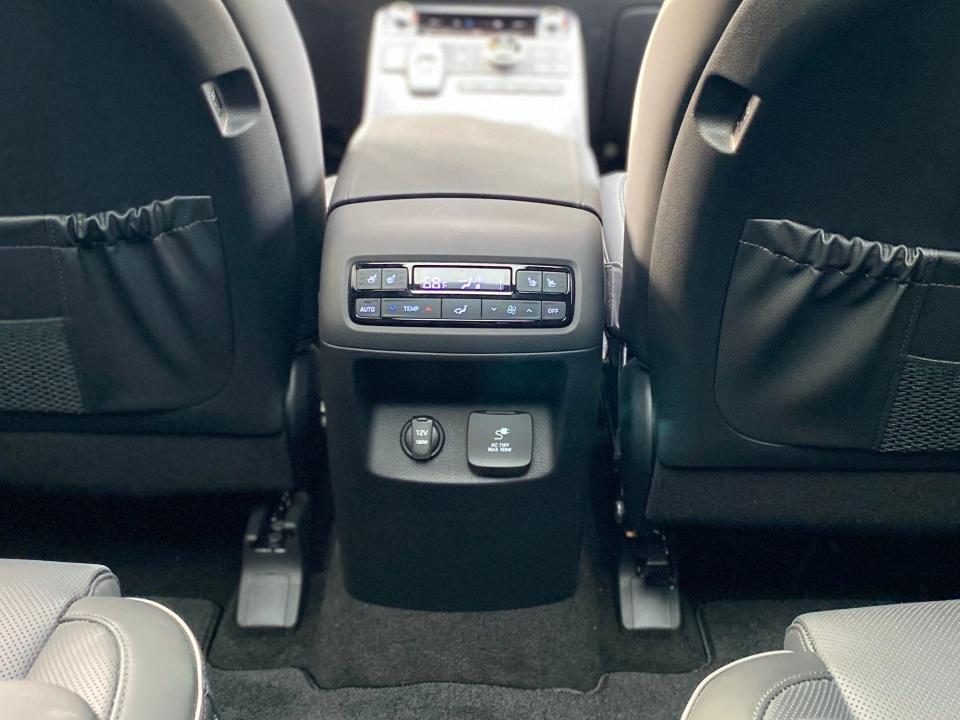

There is also an AC power plug for laptops and a 12V plug.
Instead of its traditional location next to the climate controls, the second USB-C plugs are placed on the back of the front seats.
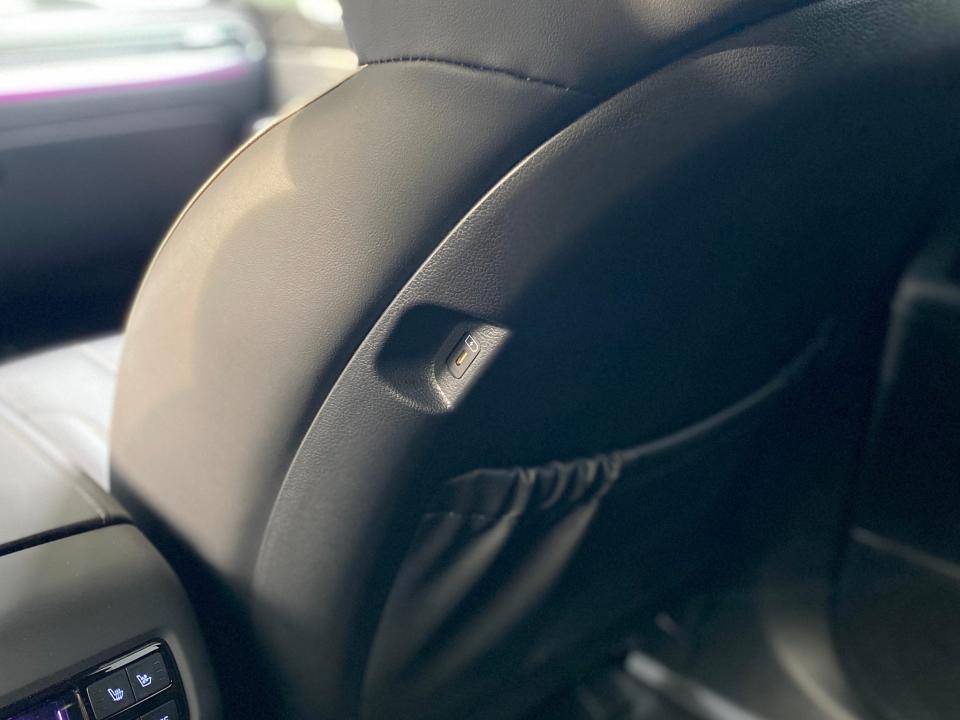

I’m still undecided as to whether this placement of the plugs is an improvement over their traditional spot.
The Palisade third-row bench seat has room for three.


The third row boasts 31.4 inches of legroom. It’s roughly the same as the Subaru Ascent but trails the Honda Pilot by about an inch. However, the Palisade beats out the Toyota Highlander by about 3.5 inches.
As with most third rows in this vehicle class, it’s best reserved for short trips around town or for children.
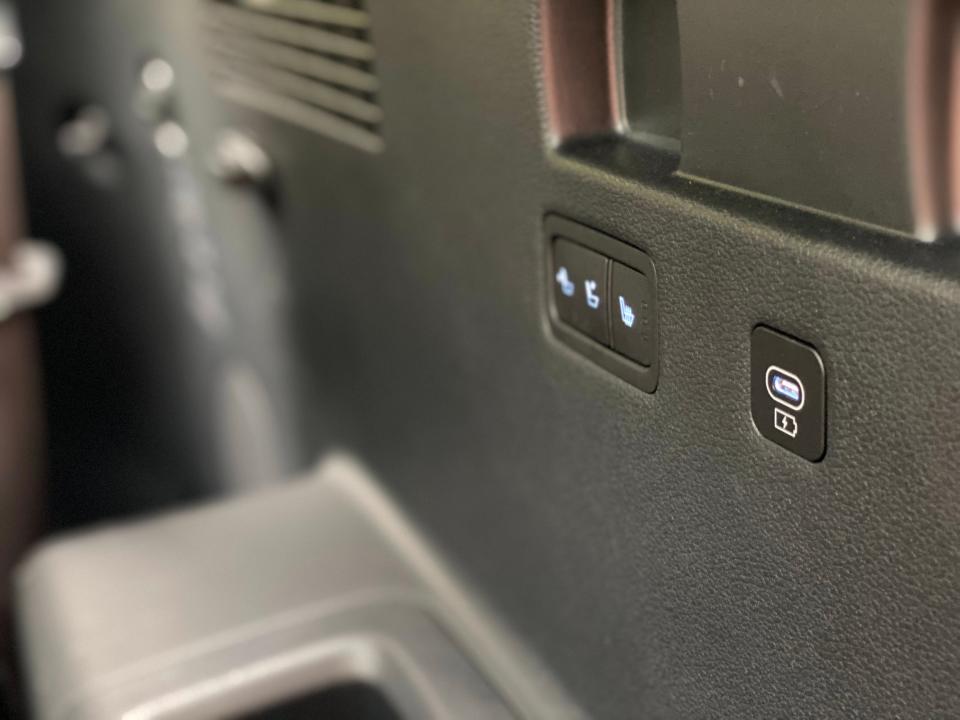

Fortunately for Palisade owners, the third-row seats have power recline and are heated. There are also two USB-C plugs back there.
The Palisade is equipped with Hyundai’s smart hands-free tailgate.
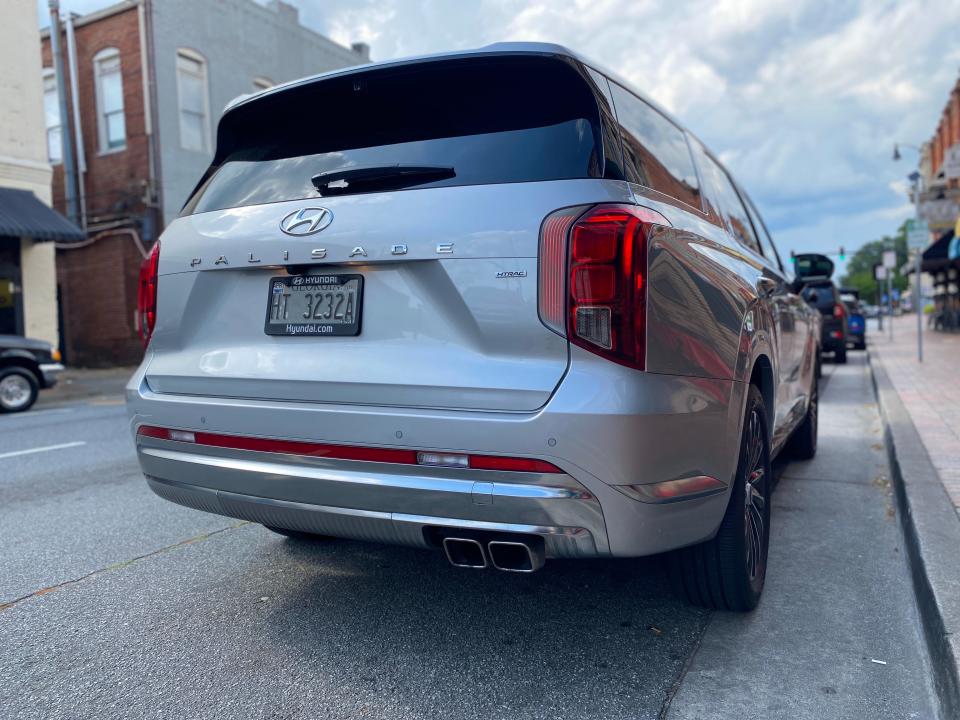

The Palisade’s liftgate triggers if you stand within 3 feet of the rear bumper for more than three seconds while possessing the key fob. This is a departure from rival systems that require the driver to swing their leg under the back bumper.
The feature is standard on all trim levels except the base SE.
Open up the liftgate, and you’ll find a roomy cargo area.
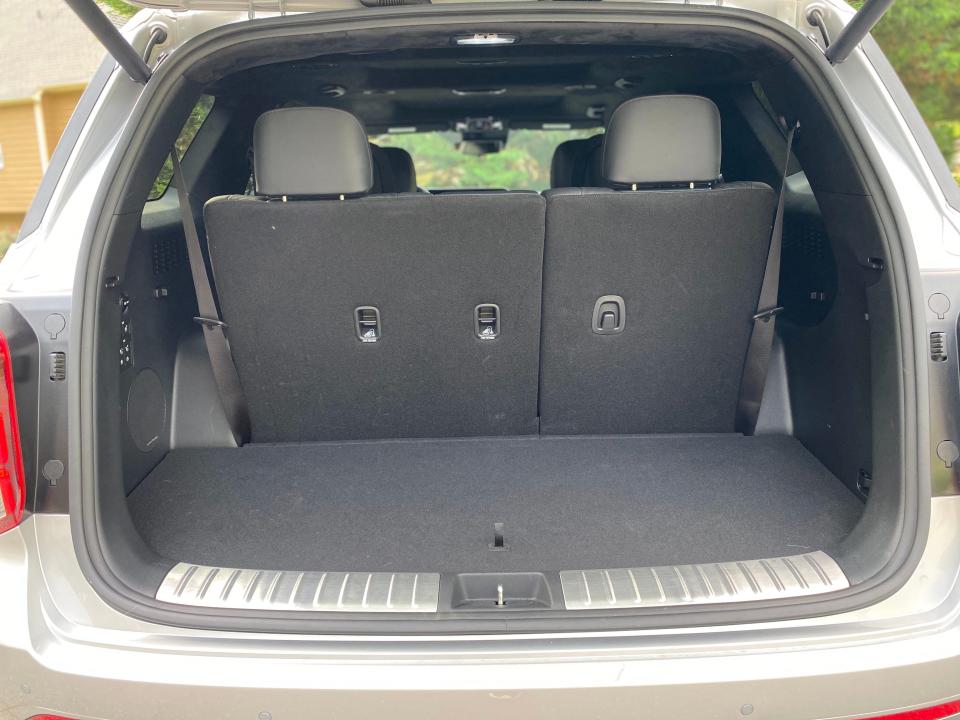

The Palisade boasts 18 cubic feet of cargo space behind the third row. That’s half a cubic foot smaller than the space in the Honda Pilot and three cubic feet smaller than the Kia Telluride. But two cubic feet larger than the Toyota Highlander.
There’s also an additional underfloor storage area behind the third row.


The underfloor storage area is home to the Palisade’s tool kit, wheel jack, and the access point for the spare tire located under the vehicle. It also offers a handy place to put items you want out of sight.
Here’s the panel of buttons in the cargo area that fold away the second and third-row seats.
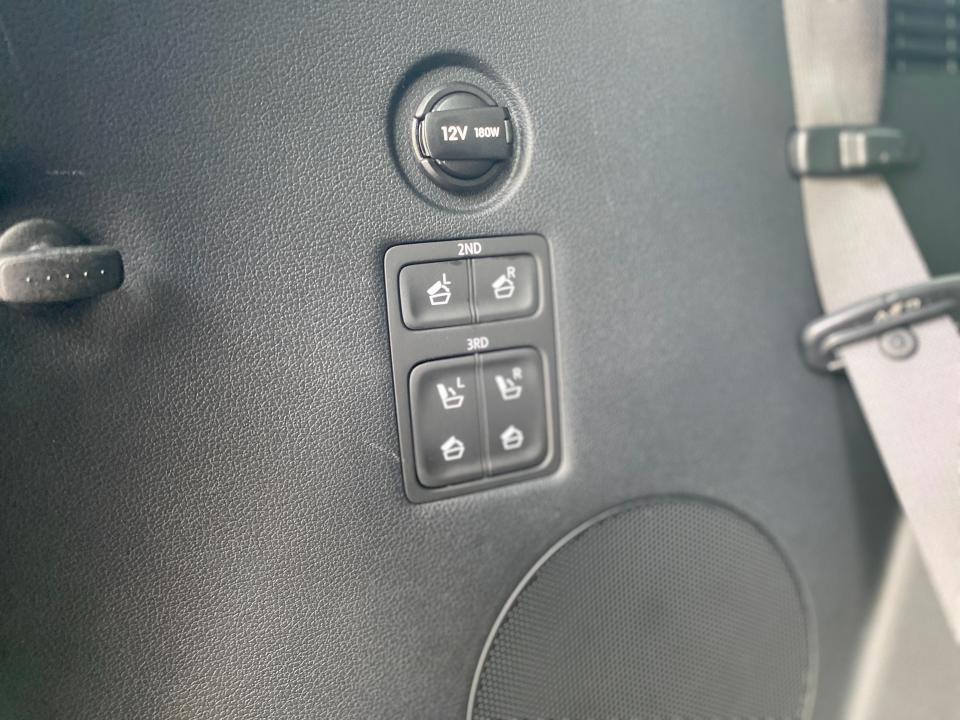

Unlike many of its competitors, the Palisade relies upon electric motors instead of manual latches or handles to get the job done.
The Palisade boasts 45.8 cubic feet of cargo room with the third row folded.
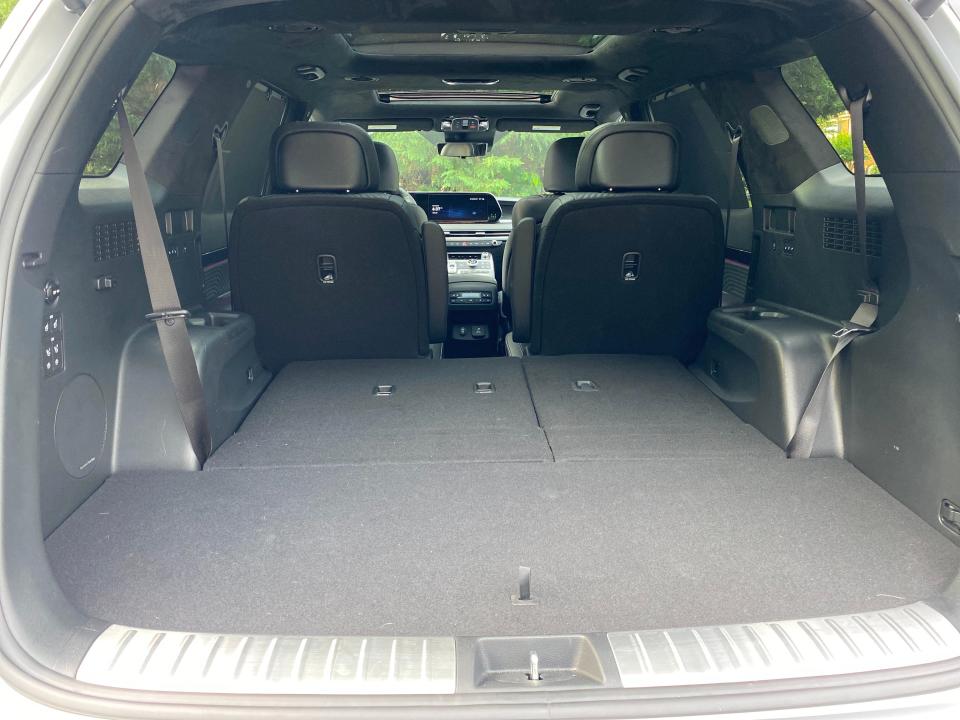

That’s roughly the same as the Kia Telluride, but three cubic feet less than the Honda Pilot and Toyota Highlander.
In total, the Palisade boasts 86.4 cubic feet of cargo room behind the front seats.
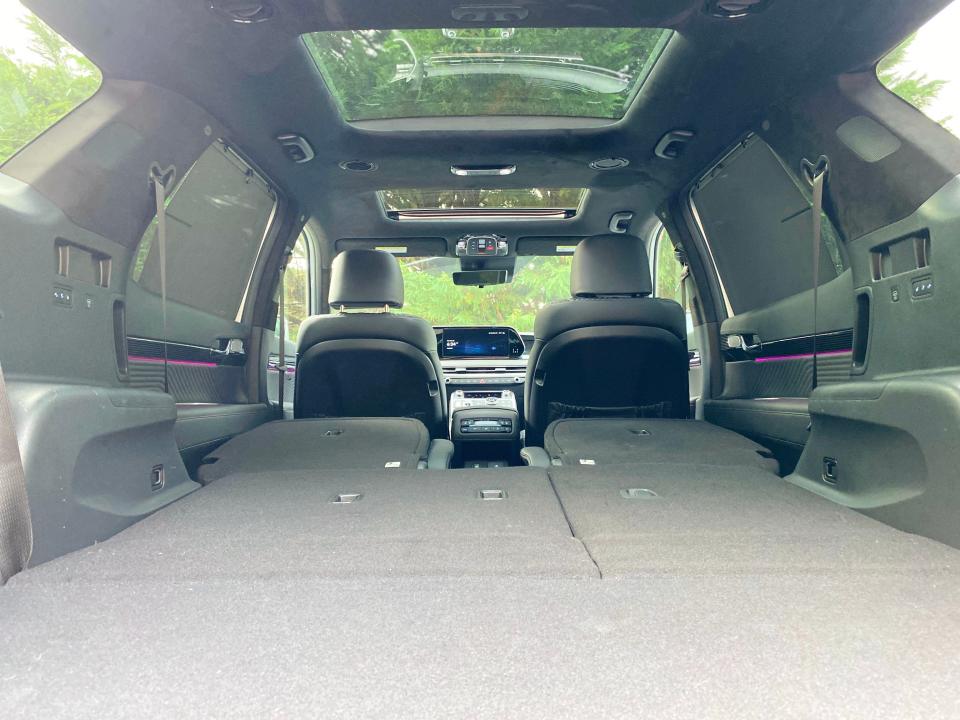

This figure is about half a cubic foot less than the Telluride and Pilot but two cubic feet more than the Toyota Highlander.
The Palisade is equipped with a host of advanced safety features.
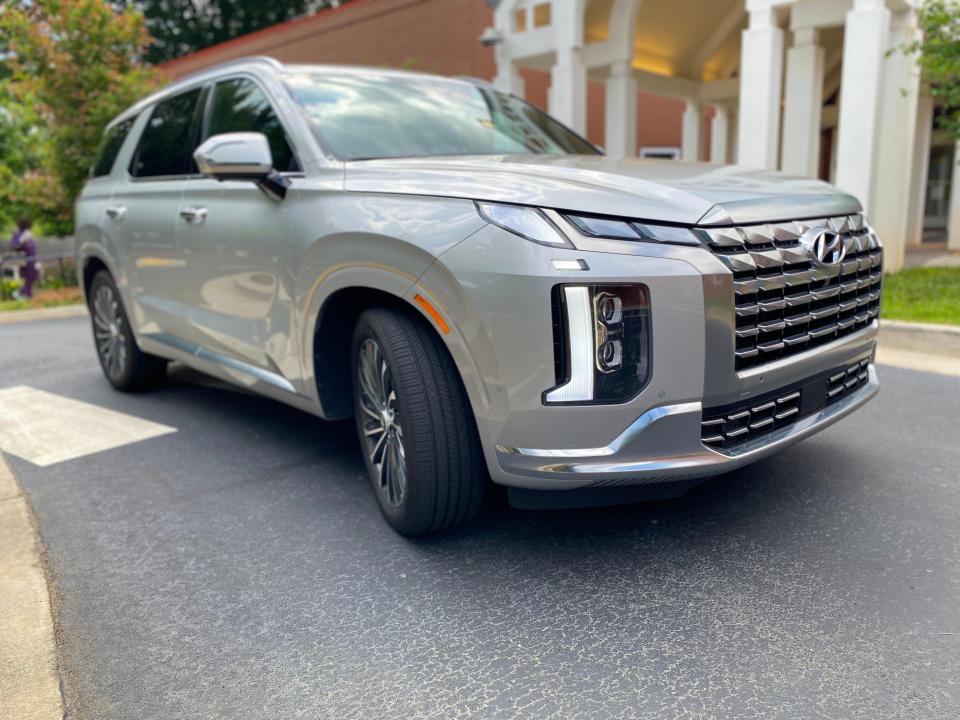

All Palisades come standard with blindspot collision warning, rear cross-traffic collision avoidance assist, rear occupant alert, rear park distance warning, forward collision avoidance assist, lane keeping assist, lane following assist, driver attention warning, trailer sway control, and highway driving assist.
The Calligraphy trim gets forward park distance warning, parking collision avoidance assist, and upgraded forward collision avoidance assist.
The verdict: It’s one of the finest family SUVs I’ve ever driven.
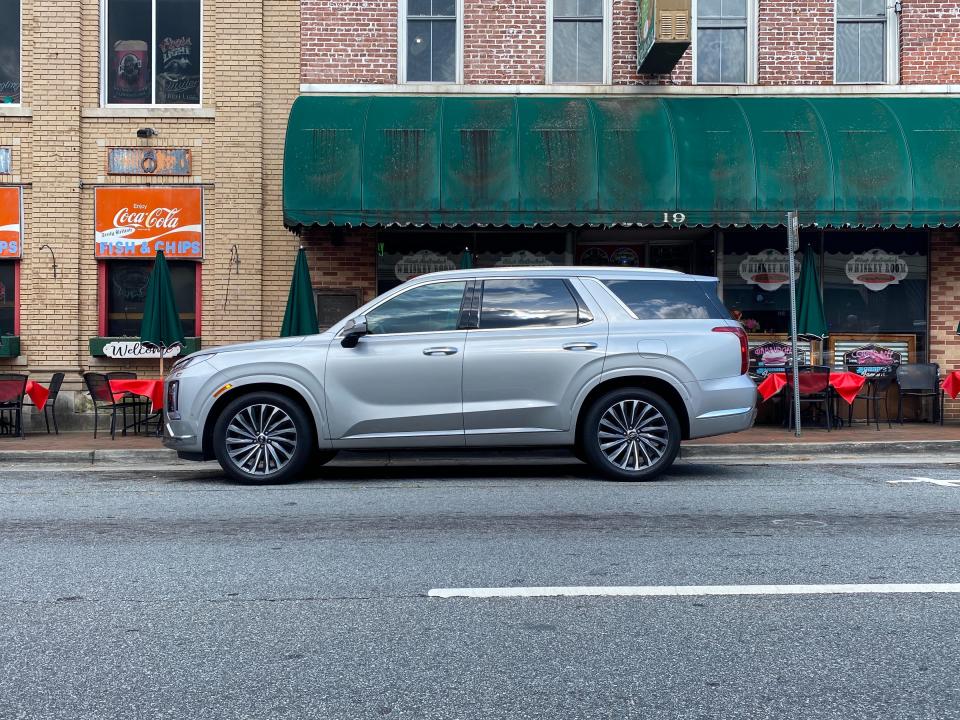

I’ve long heard the praise consumers and the automotive media have heaped on the Palisade, but I hesitated to buy into the hype.
After all, it’s incredibly rare for an automaker to get things this right on their first shot in a hyper-competitive segment where the margin between success and failure is razor-thin.
Boy was I wrong.
As a mass-market family SUV, the Palisade was impressive and massively punched above its weight.
Or in this case, its price tag.
For just over $50,000, Hyundai’s Palisade Calligraphy delivered a degree of refinement, quality, and feature content that wouldn’t feel out of place on one of its Genesis models.
Read the original article on Business Insider
Source Agencies



